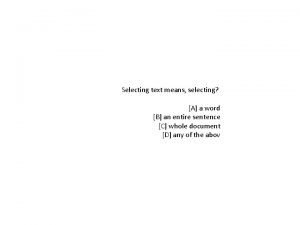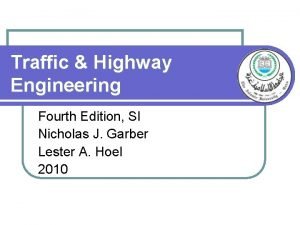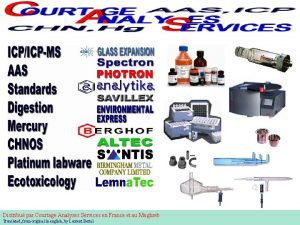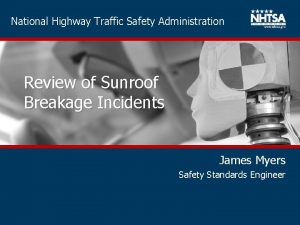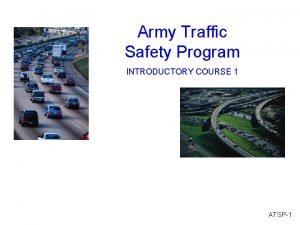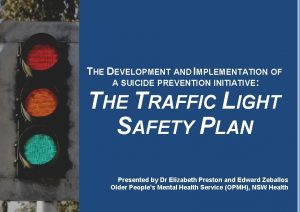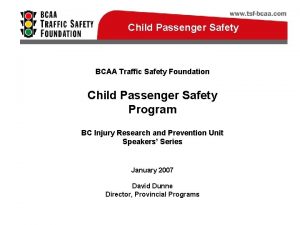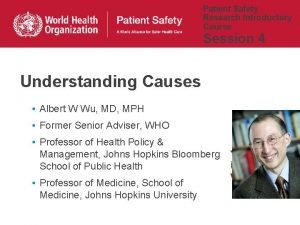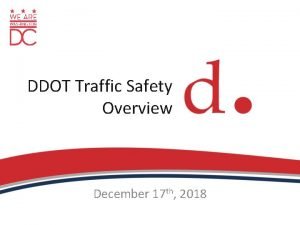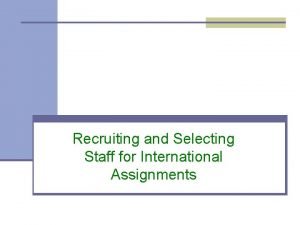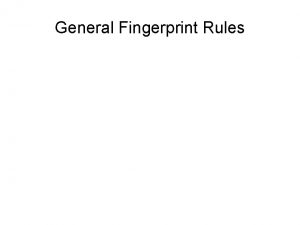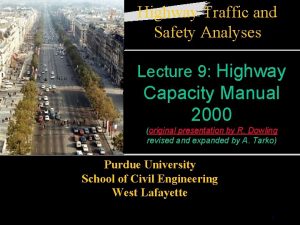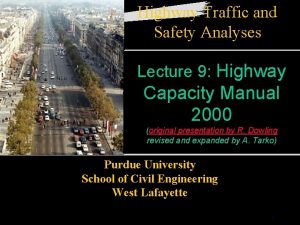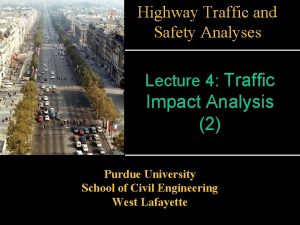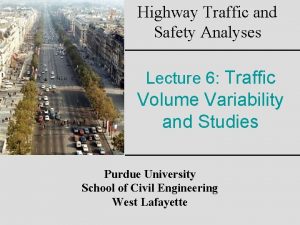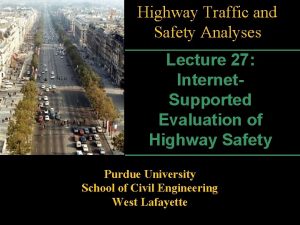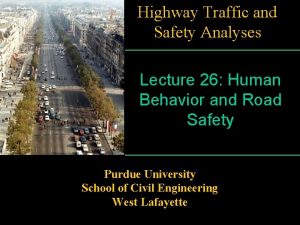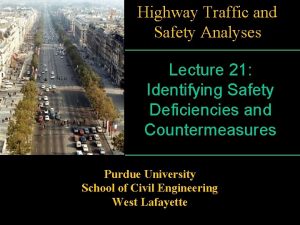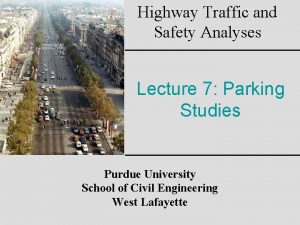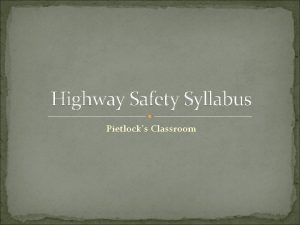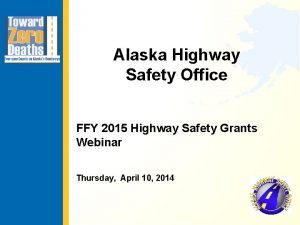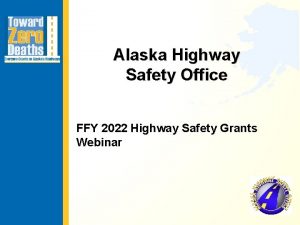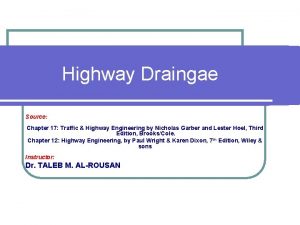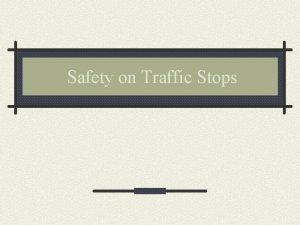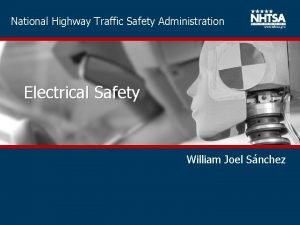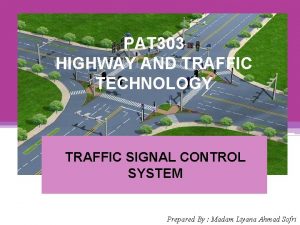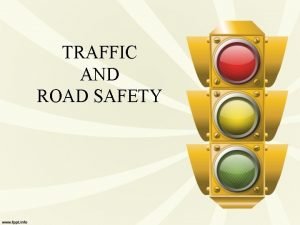Highway Traffic and Safety Analyses Lecture 23 Selecting














![COUNTERMEASURE Crash Reduction Factors Example Indiana Values All Install Inside Shoulders [AA] b a) COUNTERMEASURE Crash Reduction Factors Example Indiana Values All Install Inside Shoulders [AA] b a)](https://slidetodoc.com/presentation_image_h2/ad54c5a6a836671acd573e972833945f/image-15.jpg)




- Slides: 19

Highway Traffic and Safety Analyses Lecture 23: Selecting Safety Projects Purdue University School of Civil Engineering West Lafayette

Safety Management System Decision-making Process • • Identify highway hazard Determine the causes Determine countermeasures Develop safety projects Select projects for implementation Implement the selected projects Evaluate projects’ effectiveness (beforeand-after studies) Next year Updating CRFs

Safety Projects • A safety project includes a set of improvements for a certain location. The improvements should be justified with the site investigation. • A safety project should be specific sufficiently to evaluate its cost with reasonable accuracy. • A safety project should have predicted number of crashes saved in each considered category.

Selection Tasks Task 1 From potential projects for a single location, select the most cost-effective one. The selected project has to be feasible (benefits exceed costs). Task 2 From projects identified for multiple locations in Task 1, select a subset of projects that promise the highest total safety improvement and the total cost fits the budget.

Benefit-to-Cost Ratio – Benefit = Cost of the saved crashes during the period of analysis – Cost = Installation/construction and maintenance costs during the period of analysis, salvage value (negative or positive) – Period of analysis = project lifetime, sequence of project lifetimes – Present worth or equivalent annual amount methods

Time Frame for Economic Evaluation Implementation year (PI) Present year (PY)

Cost Components (GT)

Present Benefit Present year (PY) Implementation year (IY) Y 4 Y 3 Y 2

Present Benefit

Present Cost

Equivalent Uniform Annual Benefit Equivalent Uniform Annual Cost

Economic Effectiveness Benefit-to-Cost Ratio Net Annual Benefit Present Worth Net Benefit

Project Lifetime Examples from Hazard Elimination Safety – Program Criteria, Minnesota Department of Transportation, Feb. 1994 Improvement Lifetime (Years) Construct turning lanes at intersections 10 Improve sight distance at intersection 10 Install traffic signs 6 Install pavement marking 2 Widen traveled way 20 Install median barrier 15 Construct pedestrian overpass/underpass 30 Improve RR crossing surface 10 Relocate highway to eliminate RR crossing 30

Crash Frequency Safety Performance Function and Counts Safety performance function = 0. 2, over-dispersion factor; a = 6. 2, crash frequency estimate; Crash counts c = 16, crash count; n = 2, number of years; Final estimate of crash frequency:
![COUNTERMEASURE Crash Reduction Factors Example Indiana Values All Install Inside Shoulders AA b a COUNTERMEASURE Crash Reduction Factors Example Indiana Values All Install Inside Shoulders [AA] b a)](https://slidetodoc.com/presentation_image_h2/ad54c5a6a836671acd573e972833945f/image-15.jpg)
COUNTERMEASURE Crash Reduction Factors Example Indiana Values All Install Inside Shoulders [AA] b a) Rural Multi-Lane 4 feet shoulders 6 feet shoulders b) Urban Multi-Lane 4 feet shoulders 6 feet shoulders Fatal or Injury PDO 70 84 56 71 Widen Lane a)Rural Two-Lane [AA] b Add 1 Foot to Both Lanes Add 2 Feet to Both Lanes 16 29 20 37 12 22 b)Urban Two-Lane [AA] b Add 1 Foot to Both Lanes Add 2 Feet to Both Lanes 16 30 24 12 12 22 Widen Median [AA]b Rural Multi-Lane Widening 4 Feet Widening 10 Feet Widening 20 Feet 19 42 66 10 23 41 21 44 68 Widen Median at Intersections [AA]b Widening 4 Feet Widening 10 Feet Widening 20 Feet 5 12 23 6 14 26

Crash Costs • Oregon Department of Transportation – injury and fatal crashes (1995) Location Urban Rural Freeway State highway 62, 500 60, 000 121, 400 122, 800 County/Local City 60, 800 54, 400 105, 500 N/A

Crash Costs • Minnesota Department of Transportation (1994) PDO = $2, 000; INJ = 26, 500; F = $500, 000 • Wisconsin Department of Transportation (1997) PDO = $7, 000; INJ = 35, 000; F = $70, 000 • Michigan Department of Transportation (1997) PDO = $1, 600; INJ = 10, 800; F = $240, 000

Crash Costs • Maryland Department of Transportation, state roads (1996) Crash severity Urban Rural All roads Fatal 3, 572, 000 3, 704, 000 3, 635, 780 Injury 114, 700 115, 800 115, 003 Property Damage Only 23, 800 19, 650 22, 675 All crashes 124, 483 100, 634 91, 579

Procedure 1. Define potential projects for each hazardous location 2. Estimate the B/C and NAB for each project 3. Eliminate projects with B/C 1 4. Select projects with the highest B/C or NAB for each hazardous location 5. Find such subset J of projects that Max j J NABj s. t. j J CCj ≤ Budget Constrained knapsack problem
 Selecting text means selecting
Selecting text means selecting Traffic and highway engineering 4th edition
Traffic and highway engineering 4th edition Thinks critically and analyses nursing practice
Thinks critically and analyses nursing practice Molecular ecological network analyses
Molecular ecological network analyses Rhetorical analysis
Rhetorical analysis Icp courtage
Icp courtage Incomina
Incomina All traffic solutions
All traffic solutions National highway safety administration reviews
National highway safety administration reviews 01:640:244 lecture notes - lecture 15: plat, idah, farad
01:640:244 lecture notes - lecture 15: plat, idah, farad Army traffic safety introductory course
Army traffic safety introductory course Traffic light safety plan mental health
Traffic light safety plan mental health Brekford traffic safety
Brekford traffic safety Bcaa traffic safety foundation
Bcaa traffic safety foundation Army traffic safety introductory course
Army traffic safety introductory course Ddot traffic safety assessment
Ddot traffic safety assessment Selection criteria for international assignments
Selection criteria for international assignments Rules governing the selection of core
Rules governing the selection of core Identification of the system for development
Identification of the system for development Selecting and storing eggs
Selecting and storing eggs
